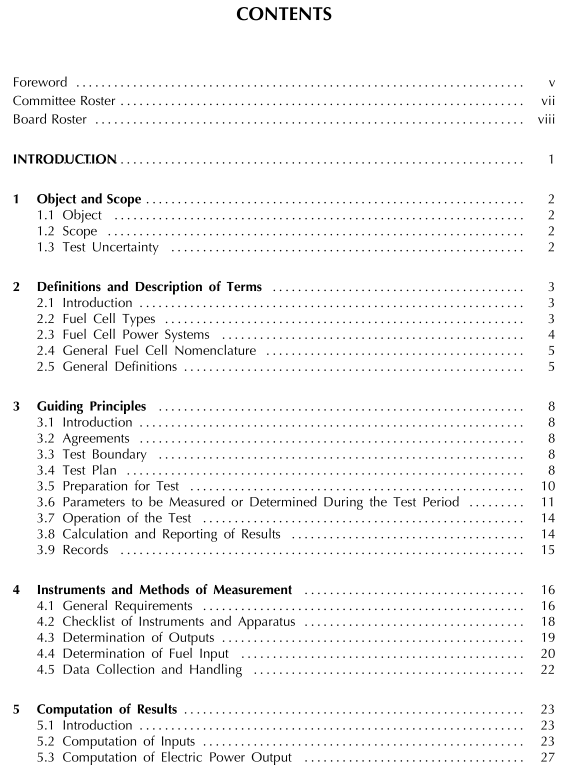ASME PTC-50:2002 pdf download FUELCELL POWERSYSTEMS PERFORMANCE
2.1 INTRODUCTION Fuel cell power systems convert the energy of a fuel and an oxidant directly into electrical energy and heat using an electrochemical process. Fuel cell power systems consist of electrochemical reactors and the balance of plant. Electrochemical reactors convert the energy from chemical to electrical form. Balance-of-plant provides the required reactant and product flows, to and from the electrochemical reactors, and converts the power output to a usable form, such as AC power for a utility grid. There are a number of different types of fuel cells, and within each fuel cell type, designers have a variety of options for configuration of balance of plant systems. The basic type of fuel cell is defined by the chemistry of the materials used in the cell components. Section
2.2 below describes five of the most common fuel cell types currently being commercialized. Section
2.3 discusses the various components and subsystems that make up fuel cell balance of plant systems.
2.2 FUEL CELL TYPES
2.2.1 Classification of Fuel Cells. The most common classification of fuel cells is by the type of electrolyte used in the cells and includes:
(a) polymer electrolyte membrane, also referred to as proton exchange membrane (PEMFC)
(b) alkaline fuel cell (AFC)
(c) phosphoric acid fuel cell (PAFC)
(d) molten carbonate fuel cell (MCFC)
(e) solid oxide fuel cell (SOFC) These fuel cells are listed in the order of approxi- mate operating temperature, ranging from ~80°C for PEMFC,~1 00°C for AFC, ~200°C for PAFC, ~650°C for MCFC, and ~800°C to ~1 000°C for SOFC. In addition to these fuel cell types, development is proceeding on other types of fuel cell power systems. The operating temperature and useful life of a fuel cell are a result of the properties of materials used in the cell components (i.e., electrodes, electrolyte, interconnect, current collector, etc.). Aqueous 3 electrolytes are limited to temperatures of about 200°C or lower because of their high water vapor pressure and/or rapid degradation at higher tempera- tures.
The operating temperature also plays an important role in dictating the type of fuel that can be utilized in a fuel cell. The low-temperature fuel cells with aqueous electrolytes are, in most applications, restricted to hydrogen as a fuel. In high-temperature fuel cells, CO and even CH 4 can be used because of the inherently rapid electrode kinetics and the lesser need for high catalytic activity at high temperature.
2.2.2 Description of the Various Electrolyte Cells. The following descriptions indicate the range of systems currently available.
They are not meant to restrict the scope of this Code in any way. This code can be applied for all fuel cell types some of which may not be listed here. Alkaline Fuel Cell (AFC): the electrolyte in this fuel cell is an aqueous KOH solution, retained in a wicking matrix, and the cells typically operate at 1 00°C. A wide range of electro-catalysts has been used (e.g., Ni, Ag, metal oxides, spinels, and noble metals). The fuel supply is limited to nonreactive constituents except for hydrogen. CO is a poison, and CO 2 will react with the KOH to form K 2 CO 3 , thus altering the electrolyte.
Even the small amount of CO 2 in air must be considered with the alkaline cell. Fuel Cell Reformate: reformed fuel output (usually gaseous) from the fuel reformer. The fuel reformer is used to process the input hydrocarbon fuel into a fuel stream (the reformate) that matches the fuel cell stack parameters and meets the needs of the fuel cell system. Fuel Cell Reformate typically consists of the H 2 , CO, H 2 O results from a steam reforming process. For some fuel cell types, such as MCFC and SOFC, this is utilized directly in the fuel cell stack. For other fuel cell types, such as PEM, the stream is converted to a hydrogen rich gas, with minimal amounts of contaminants but sometimes containing nonreactive compounds such as nitrogen, carbon dioxide, or other nonreactive compounds that can pass through the anode in the unreacted state.
ASME PTC-50:2002 pdf download
